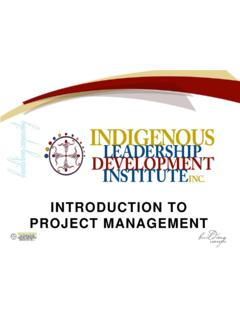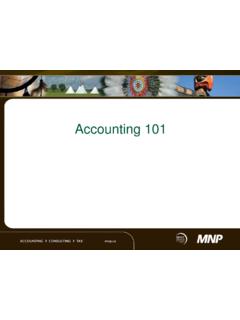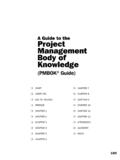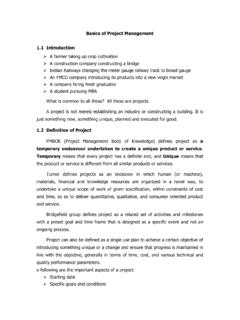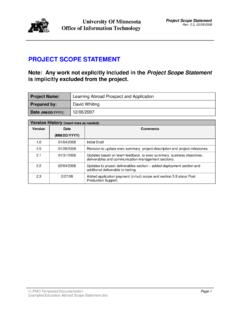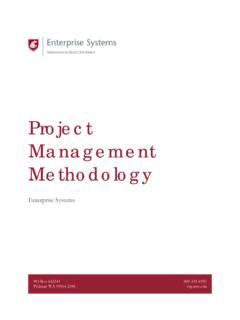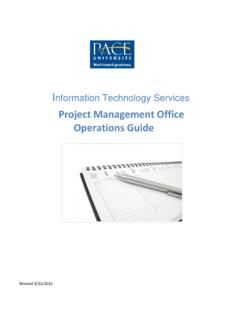Transcription of INTRODUCTION TO PROJECT MANAGEMENT - EDO
1 INTRODUCTION TO PROJECT MANAGEMENT INTRODUCTION to PROJECT MANAGEMENT OVERVIEW The purpose of presentation is to provide leaders and team members of projects, committees or task forces with advanced techniques and practical skills for initiating, planning, tracking, controlling and evaluating any kind or size of PROJECT . On time On budget Meeting the goals that have been agreed upon A PROJECT is an activity that : is temporary having a start and end date is unique brings about change has unknown elements, which therefore create risk WHAT IS A PROJECT ? Generally projects are formed to solve a problem or take advantage of an opportunity. Business as usual activities can often be mistaken for projects.
2 Generally it is the uniqueness of the activity that is the deciding factor do we do this every year? If so, then it is not truly a PROJECT although you can use PROJECT methods to get it done. Building a deck Implementing a new system Mowing the lawn Planning a wedding Planning a fundraiser Planning a student graduation Ye s No Ye s No Ye s No Ye s No Ye s No Ye s No QUIZ ARE THESE PROJECTS? Deliverables: Tangible things that the PROJECT produces Milestones: Dates by which major activities are performed. Ta s ks: Also called Actions. Activities undertaken during the PROJECT Risks: Potential problems that may arise Issues: Risks that have happened Gantt Chart: A specific type of chart showing time and tasks.
3 Usually created by a PROJECT MANAGEMENT program like MS PROJECT . Stakeholder: Any person or group of people who may be affected by your PROJECT COMMON PROJECT TERMS EXAMPLE: Building a deck Deliverables: A plan, a consent form, the deck Milestones: Tasks: Plan drafted Plan approved 1 Jun 15 Jun Plan submitted Plan approved 16 Jun 19 Jun Materials purchased Resources booked Equipment identified Deck constructed Deck tested Deck quality approved Deck warming completed 16 Jul 16 Jul 16 Jul 20 Jul 24 Jul 24 Jul 28 Jul tasks Subtasks Plan drafted Requirement gathered Best practice researched Draft 1 prepared Distributed to stakeholders Plan approved Feedback gathered Amendments made Final plan prepared Distributed to stakeholders Sign-off obtained WBS Hierarchy of tasks required to complete PROJECT Each task is broken into smaller tasks that can be managed and estimated Define task
4 Dependencies Some tasks must begin at the same time, some must end at the same time and some cannot start until the other tasks have finished. Estimate task durations and cost May be inputted into PROJECT MANAGEMENT software Final WBS plan is called baseline WBS WORK-BREAKDOWN STRUCTURE Risks: Plan is not approved after first round of feedback Resources are not available at the required time Plan is not given consent For each of the above, you should have a contingency plan, or do some activity that may prevent it happening in the first place. Issues: If any of the above actually happens, then it becomes an issue to solve. Gantt Chart: Stakeholder: House owner, Builder, Council, ?
5 ?? A successful PROJECT Manager must simultaneously manage the four basic elements of a PROJECT : resources, time, money, and most importantly, scope. All these elements are interrelated. Each must be managed effectively. All must be managed together if the PROJECT is to be a success. The resource that can be leveraged to the greatest extent in all projects is the people involved. A person with a diverse set of skills MANAGEMENT , leadership, technical, conflict MANAGEMENT , and customer relationship who is responsible for: initiating, planning, executing, controlling, monitoring, and closing down a PROJECT . THE PROJECT MANAGER PROJECT Managers are essentially jugglers.
6 They must make sure that everything keeps to task, that potential issues are quickly eliminated and the PROJECT is delivered on time, all the while making sure everyone knows what is happening and the PROJECT quality and budget are acceptable. Specifically they: direct all activities required to successfully meet the PROJECT objectives manage risk scanning ahead for potential issues and resolving them before they become a problem solve problems - recommending alternative approaches to problems that arise and providing guidance to the PROJECT Sponsor track and report PROJECT progress communicate to all stakeholders in the PROJECT Ultimately responsible for the PROJECT s Success Plan and Act Focus on the PROJECT s end Be a manager & leader The Initiation phase of the PROJECT is the most important phase.
7 The success of the entire PROJECT depends on how clearly and completely the Terms of References are established. PROJECT Sponsor Lines of Authority Participants Objectives PROJECT INITIATION - Constraints - Costs/Budget - Resources - Deliverables - Phases & Time Scales - Strategy - Risks - Roles & Responsibilities PROJECT INITIATION con t A PROJECT contains a well defined objective. The PROJECT objective is defined in terms of scope ( or requirements), schedule, and cost. A PROJECT is carried out via a set of interdependent tasks. A PROJECT uses various resources to carry out these tasks. CHARACTERISTICS OF PROJECTS A PROJECT has a definite start date and an expected completion date.
8 The actual completion date may not always be the same as the expected date. A PROJECT is a one time or unique endeavor. A PROJECT has a customer. So why do projects fail? PROJECT and program MANAGEMENT discipline of executive-level support team members communication measures for evaluating the success of the PROJECT risk MANAGEMENT to manage change WHY DO PROJECTS FAIL? A PROJECT has a degree of UNCERTAINTY. In PROJECT planning many assumptions are made regarding: access to resources. resource capability. impact of environmental factors. These assumptions are not always accurate. Requires PROJECT managers to re-assess and trade-offs between requirements, costs, and time.
9 Above all, be PRO-ACTIVE. We measure the success of a PROJECT using 4 major PROJECT constraints, specifically: Scope. Cost. Schedule (Time). Customer satisfaction (quality and performance). MEASURING PROJECT SUCCESS PROJECT scope Have all the PROJECT requirements ( , deliverables) been completed? PROJECT cost Is the cost of the PROJECT close to the amount the customer has agreed to pay? Schedule Was the PROJECT completed on time? Customer satisfaction Is the customer happy with the quality of the PROJECT ? PROJECT CONSTRAINTS Rule #1 Thou shalt gain consensus on PROJECT outcome. Rule #2 Thou shalt build the best team possible. Rule #3 Thou shalt develop a comprehensive, viable plan and keep it up-to-date.
10 Rule #4 Thou shalt determine how much stuff you really need to get things done. PROJECT SUCCESS 12 Golden Rules Rule #5 Thou shalt have a realistic schedule. Rule #6 Thou won t try to do more than can be done. Rule #7 Thou will remember that people count. Rule #8 Thou will gain the formal and ongoing support of MANAGEMENT and stakeholders. Rule #9 Thou must be willing to change. Rule #10 Thou must keep others informed of what you re up to. Rule #11 Thou must be willing to try new things. Rule #12 Thou must become a leader.
